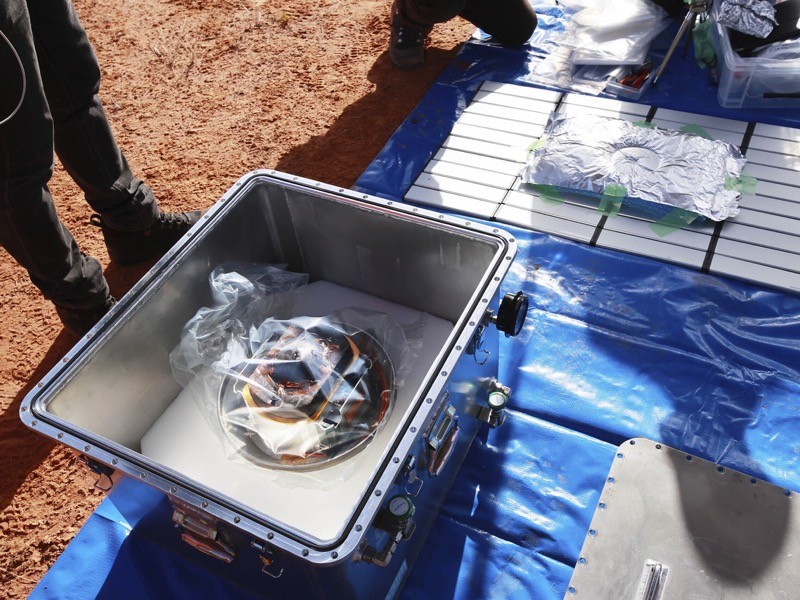Japan’s mission to bring asteroid dust back to Earth has succeeded. The Japan Aerospace Exploration Agency (JAXA) confirmed on 14 December that a capsule from spacecraft Hayabusa2, which landed in the Australian desert last week, contained black grains from asteroid Ryugu.
“The confirmation of sample is a very important milestone for us and for JAXA,” says Yuichi Tsuda, project manager for the mission at JAXA, in Sagamihara.
JAXA said in a statement that they observed the sandy material at the entrance of the collection chamber, but have yet to look inside to see if more asteroid dust is lurking there. It is only the second time that scientists have returned material from an asteroid.
The samples from Ryugu could give researchers important insights into the early evolution of planets, and help to explain the origins of water on Earth1,2.
“The samples containing precious asteroid material will provide scientists with key information about the formation of the Solar System,” says Ed Kruzins, director of the Canberra Deep Space Communication Complex, at the Commonwealth Scientific and Industrial Research Organisation, which helped track the spacecraft and its encounter with Ryugu.
The capsule’s journey
In the early hours of 6 December, a brilliant fireball streaked through the southern skies and landed in the desert in South Australia, setting off a race to locate the capsule that scientists hoped contained material from Ryugu.
“Images that Hayabusa2 took during its landing operations made us confident that the spacecraft collected Ryugu samples,” wrote Satoru Nakazawa, deputy manager of the mission, in an email while in Woomera, Australia. But the team couldn’t know for sure until they disassembled the capsule and sighted the dark dust.
Some 57 hours after the capsule was located, the team delivered it back to Japan. The swift shipment “means that the samples we got from Ryugu are very pure without contamination from the Earth’s atmosphere and we confirmed that there was no leakage,” says Yuichi Tsuda, project manager for the mission at JAXA, in Sagamihara.
Plans for the samples
Once the capsule is fully unsealed, possibly later today, JAXA scientists will measure the materials’ mass and study its composition and structure. They hope to have collected at least 0.1 grams of material, says Yoshikawa Makoto, mission manager for Hayabusa2 at JAXA.
Some 10% of the material will be sent to NASA in December 2021 in exchange for samples from asteroid Bennu, which spacecraft OSIRIS-Rex collected in October and should arrive on Earth by late 2023. Another 15% will be made available to international researchers, and about 40% will be stored for future scientists to investigate.
Hayabusa2 collected the samples over a year and a half of poking and prodding Ryugu — a small asteroid shaped like a squashed sphere, peppered with giant boulders3. Ryugu is a C-type, or carbon-rich, asteroid, which scientists think contains organic and hydrated minerals preserved from as far back as 4.6 billion years ago4. The samples could help to explain how Earth became covered with water. Scientists think it came on asteroids or similar planetary bodies from the outer regions of the Solar System.
Tsuda is interested in finding out whether the samples contain more complex organic material, similar to those found on Earth. “If we find very complicated organics on Ryugu, that is a very big finding.”
Hayabusa2 has now begun its 11-year journey to its next destination: a fast-rotating asteroid known as 1998 KY26. To reach it, the spacecraft will fly by another asteroid — 2001 CC21 — and swing past Earth another two times.
Article From & Read More ( Asteroid dust recovered from Japan's daring Hayabusa2 mission - Nature.com )https://ift.tt/37hIuRO
Science

No comments:
Post a Comment